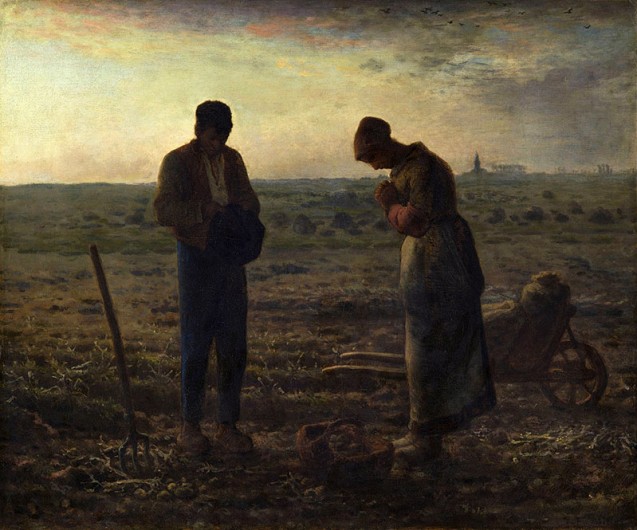The peasantry class can often be found at the heart of Jean-François Millet’s artistic work. Often featuring peasants and a social message, such as in Les Glaneuses [The Gleaners] in which they evoke the right, granted to the very poorest in society, to gather up the wheat ears after the harvest, Millet’s paintings explore the reality of rural life during the 19th century, a reality that alternated between labour and misery. Although criticised by the public and certain members of the art world for the ugliness of his figures, Millet was nevertheless recognised as one of the Second Empire’s most talented painters, receiving the Médaille de première classe in 1867 and being made a Chevallier de la Légion d’Honneur in 1868.
In this painting, the artist returns to a childhood memory: “The Angelus was painted with the thought in mind of how, when labouring long ago in the fields, my grandmother would never fail, upon hearing the bell toll, to stop us in our work in order to recite the Angelus in honour of those poor dead souls”. The painting unites a couple of peasants in prayer, as the bell ringing out the evening Angelus announces the end of the day’s work on the vast Chailly plain, near Barbizon. These two humble and touching figures, standing in a field of potatoes, became the very embodiment of rural devotion. There is, however, no religious message to the painting: Millet was simply concerned with portraying a ritualised moment of meditation taking place as the dusk rolls in.
Thomas Gold Appleton, an American passing through Paris, commissioned the painting but never returned to collect it. Instead, it passed through numerous pairs of hands before being donated to the State by Alfred Chauchard in 1909. In 1860, the painting turned up in Brussels, in the collection belonging to the Belgian minister Van Praet, who proceeded to exchange it in 1864 for another of Millet’s works, Bergère avec son troupeau [Shepherdess and her flock]. When asked to explain the swap, he noted dryly, “What can I say? It is clearly a masterpiece, but faced with these two peasants, whose work is interrupted by prayer, everyone thinks they can hear the nearby church bell tolling, and in the end, the constant ringing just became tiresome”. Irony, of course, but it ably demonstrates the power of the composition, in which the two sombre figures, dignified and reserved, are silhouetted by the falling dusk, their modest and sincere piety plain for all to see. It is perhaps this unintentionally spiritual aspect which has ensured the painting’s lasting popularity and universal appeal, transforming it into a veritable modern icon. From boxes of chocolates to Post Office calendars, rarely has a painting featured so extensively in popular imagery.
Karine Huguenaud (tr. H.D.W.)
(All links are external and in English).
April 2010


